Fertilizing flowers is a very important task, but often overlooked by newbies. So in this post, I’ll give you all you need to know, from when, how often, how much, and what type food to use. Then I’ll show you exactly how to fertilize flower garden beds and containers step by step.
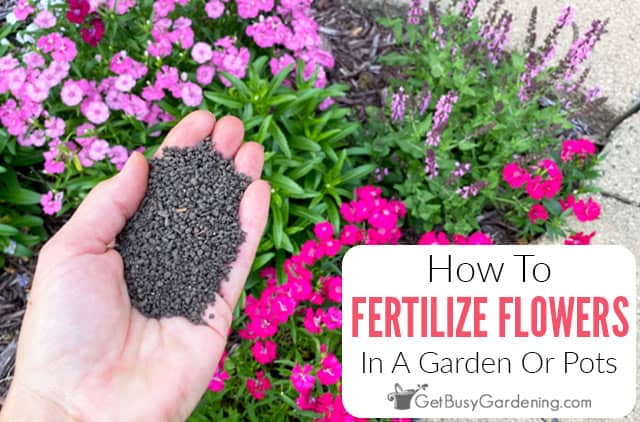
Do you feel like your flowers are lackluster and sparse most years? They might not be getting enough nutrients!
Producing blooms takes a lot of energy, and sometimes plants can’t get the necessary nutrition they need from the soil alone.
A good fertilizer provides nutrients and energy for plants so they can bloom, stay healthy, and get bigger every year. While there are lots of product choices out there, not all of them are right for fertilizing flowers.
In this guide for fertilizing flower gardens, I will walk you through how to pick the right products, and show you how to apply it to your beds and pots for plentiful blooms every season.
Why Fertilize Flowers
Plants use a lot of energy to bloom, and produce all those gorgeous flowers for us. Some are heavier feeders than others.
Many types of annuals and perennials will grow and bloom just fine without ever being fertilized, but others need an extra boost once in a while.
This is especially important for plants in containers. Once the nutrients in the potting soil run out, they can’t be replenished by nature, like they are in the ground.
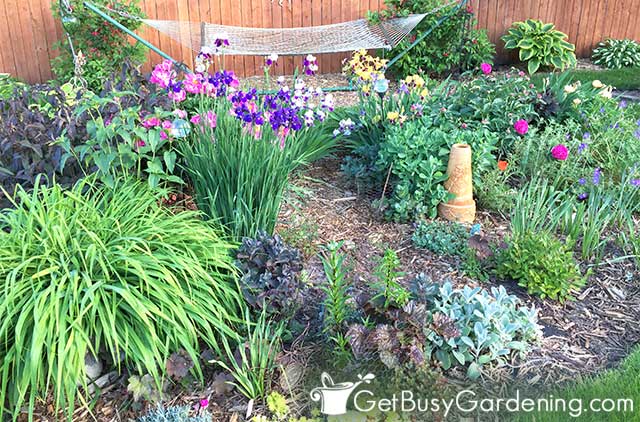
Best Fertilizer For Flowers
It’s always best to use natural, organic fertilizer on flowers, rather than chemicals. Synthetic chemicals can easily burn plants, and cause major damage. This is particularly a concern in pots, more than the garden.
Plus, those harsh chemicals strip nutrients out of the soil over time, which is terrible for the long term health of your beds.
Organic flower food works with nature to build up rich, fertile soil that’s full of the nutrients plants thrive on. Don’t worry, they are just as easy to use as the chemical brands you may already be familiar with.
One other thing that’s important for choosing the best flower fertilizer is what’s called the N-P-K numbers. Those are the numbers you usually see on the front of the package.
N-P-K stands for nitrogen, phosphorus, and potassium. Blooming plants need lots of phosphorus to produce tons of healthy buds, so look for one where the middle number is the highest (or a liquid version if you prefer).
Related Post: Guide To Choosing The Best Fertilizer For Your Vegetable Garden
Types Of Plant Food For Flowers
Very broadly, there are two types of food for flowers: slow-release and liquid. They are different in both their application, as well as how they work.
Time-release types don’t need to be applied very often, and last longer. Liquid types benefit the plants faster, but they need to be applied more often than slow-release granules.
Time-Release Fertilizer For Flowers
Slow-release plant foods can come in the form of powders, granules, pellets, or even spikes that you stick into the soil.
They last for several weeks, however they aren’t immediately available to your flowers. It takes a bit of time for them to break down enough so that they can be absorbed by the plant.
But, since they last longer, they only need to be applied a few times throughout the summer. Here are some of my favorite organic time-release flower fertilizers to use…
- Organic bud & bloom booster
- Annual & perennial pellets
- All natural flower food
- Organic blossom booster
Water Soluble Fertilizer For Flowers
Liquid plant food works faster than granules, and is available for absorption right away. But it is used up much faster, and therefore needs to be applied more often. It’s not difficult to use though.
You can mix it into your watering can, put it into a hose-end attachment, or use a handheld sprayer, and apply it each time you hydrate your beds. Here are some of my favorite natural liquid fertilizers to use in my garden…
Compost
Compost is a wonderful, natural food for flowers that you can use in outdoor containers or on your garden beds.
Simply spread it over the soil, or add it to an outdoor container potting mix. Well composted organic materials won’t burn your plants, and are much less expensive than chemical products.
When To Fertilize Flower Beds
You can fertilize flower beds and pots at any time during the morning, day, or evening, that part doesn’t make a difference.
As for the time of year, you should start feeding flowers in the spring, and stop in late summer. Do not fertilize them in the fall or winter when they are dormant.
However, always make sure the soil is moist before applying any type of fertilizer to it. Never fertilize flowers if they are dehydrated, drooping, or otherwise stressed, as this can severely damage or even kill them.
Plants that are very dry will soak up the fertilizer much quicker than those that are well hydrated, which means the risk of burning them is much higher.
So, if your plants are thirsty, be sure to give them a good drink of water, and let them soak it up before feeding them.
How Often To Fertilize Flowers
For best results, apply slow-release granules at planting time, or in early spring. Then add it again 2-3 times throughout the summer months.
With liquid fertilizers, flowers should be fed in early spring, and then again every 2-4 weeks during the summer months. To make it easier, you can give them a diluted amount each time you water.
How Much Flower Fertilizer Should You Use?
First and foremost, it’s important to understand that you can harm your plants if you use too much fertilizer. More is definitely not better here.
Over feeding isn’t as much of a concern with organic products though, which is another huge benefit of using them vs synthetic chemicals.
The exact amount you use will depend on whether your flowers are in pots or the ground, and how large the garden bed or planter is. The best thing to do is read and follow the directions on the product package.
How To Fertilize Flower Gardens
Below I will give you some general guidelines for how to fertilize flowers, which will work whether they are in the ground or pots.
These are just guidelines though, because the exact steps may vary depending on the product you’re using. So always be sure to read the label first.
Using liquid plant food – Mix the recommended amount of water soluble fertilizer with water, then slowly pour it around your flowers. You can put it in a hose attachment or a handheld sprayer to make it easier to apply to large garden beds.
If using chemical products, be careful not spray directly onto the foliage, especially when it’s sunny. This can burn the leaves, and cause severe damage to the plant.
Applying granular fertilizers – Spread the granules evenly over the top of the soil, and around the base of the plants. Take care not to get any pellets on the leaves.
Work them into the top layer of soil using a trowel or a handheld rake. After applying the dry pellets, water your flowers well so that it will start to soak in faster.
Related Post: How & When To Fertilize Your Vegetable Garden
FAQs About Fertilizing Flowers
In this section, I’ll answer some of the most frequently asked questions about fertilizing flower gardens and pots. If you can’t find the answer to your question, then ask it in the comments below.
Should you fertilize newly planted flowers?
Yes, you can add fertilizer granules to the hole when you plant your new flowers. Be sure to mix it into the soil before adding the plant, and water it well after.
What kind of fertilizer makes flowers bloom?
Phosphorus is one of the key ingredients to make flowers bloom, so look for a fertilizer where the center number is the highest. For example 4-6-4.
What time of day should I fertilize my flowers?
The time of day doesn’t matter, you can fertilizer your flower pots and beds any time during the morning, afternoon, or evening. Just take extra care not to get any liquid food on the leaves when the sun is shining.
When should you NOT fertilize flowering plants?
Don’t fertilize flowering plants when they are dehydrated. When they’re very dry, they will soak up the fertilizer faster, and the risk of burning them is much higher during this time.
While it’s not complicated, fertilizing flowers is a necessary task during the growing season. Keep your flowers fed with the right balance of nutrients, so they can produce big, beautiful blooms for you to enjoy all summer long.
More About Flower Gardening
- How To Grow Canna Lilies: Complete Care Guide
- How To Keep Peonies From Falling Over
- Rain Gardens: A Detailed Guide For Beginners
- How To Grow Hydrangeas: Complete Care Guide
Share your best tips for fertilizing flowers (in gardens or pots) in the comments below!
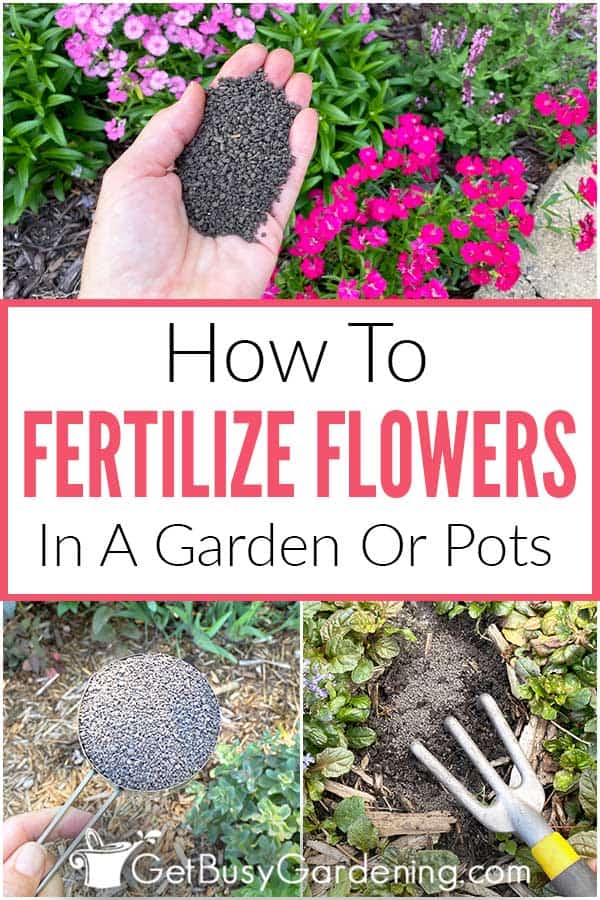
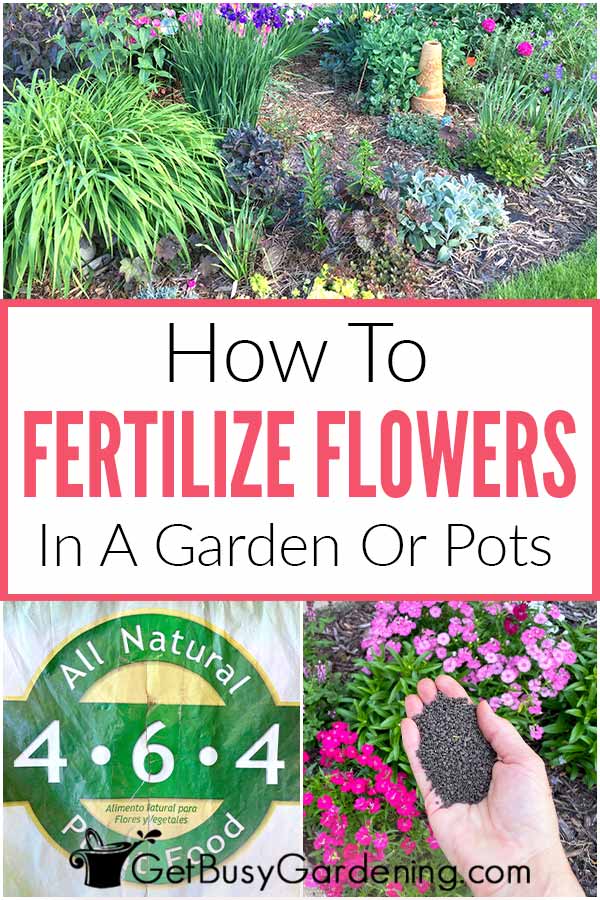
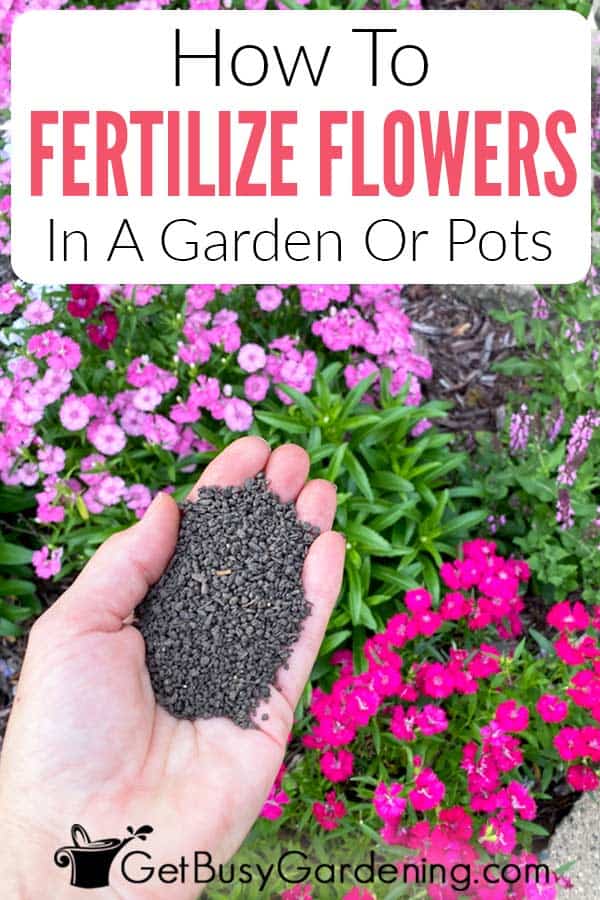

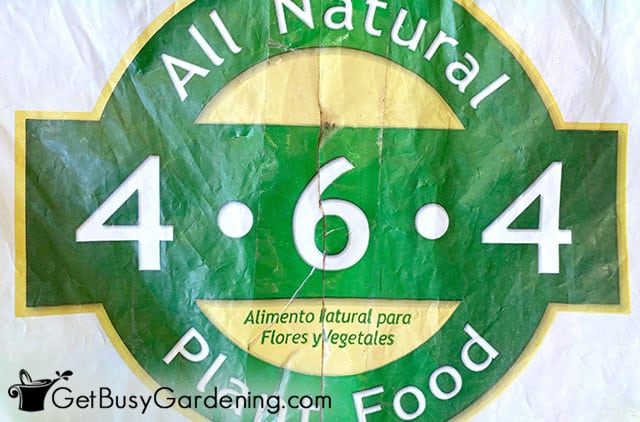
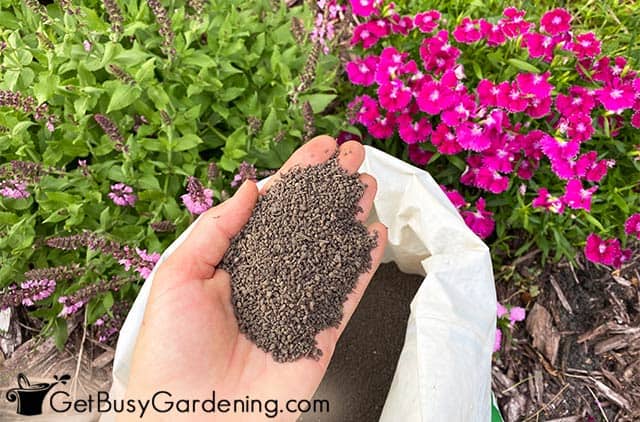
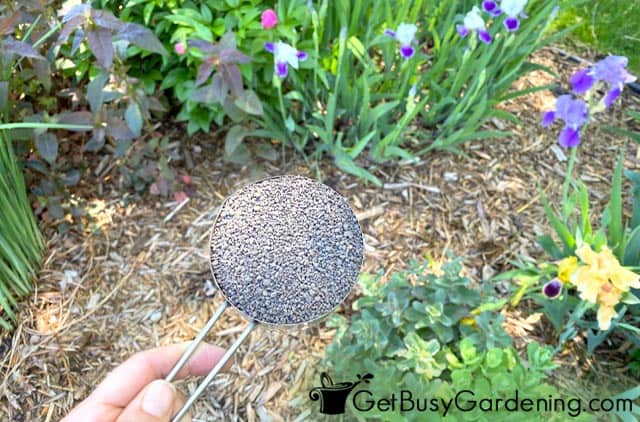


Diane Rogers says
Can the vegetable/herb, granular, be worked into raised beds in the fall for spring planting or best to wait until spring as not to waste? My beds are in need of “nutrients ” and I am in NW Ohio. Zone 6a and 6b
Thank you for any help you offer!!
Amy Andrychowicz says
I don’t recommend using vegetable/herb fertilizers in your flower beds, instead use one that is specifically made for flowering plants. I linked to several good options throughout the article. It’s best to wait to add it to your perennial beds in the spring and summer, as fall feeding could trigger new growth that can easily be damaged by frost. If however you’re asking about your veggie rather than flower beds, then here’s how to prepare it for winter, including what to add in the fall for spring planting.
Sabrina says
I live in California & in my area, we get Indian Summers. Our warm summer weather starts at the end of August & ends around October. When should I use fertilizer?
Do I also fertilize evergreen, non flowering shrubs?
Amy Andrychowicz says
In general, I recommend you stop fertilizing your flowers about a month before the weather cools down for the winter. Feeding them during the late fall and winter can lead to weak growth that is more susceptible to cold and frost damage, even in warmer climates.
Susan McQuillan says
I plan to plant bulbs this fall in a plot that has been tilled but laid dormant this past year. So I fertilize it now or wait till spring? What type of fertilizer?.
Amy Andrychowicz says
You can add slow-release granules and/or compost to your flower beds before planting bulbs this fall. Here’s a post with more information to help you out… When & How To Plant Flower Spring Bulbs
Gail says
Thanks for the info about fertilizing flower gardens. I live in NW Ontario Canada. (Zone 3a) We have a colder climate, with late frosts so our gardens are late coming up in the spring. This also limits the perennials we can grow. As we’re 5 hours away from nearest Urban Centre, that are further south near Lake Superior, their growing season is different than ours, so difficult to find a nursery where we can get help. Appreciate any help we can get to improve our gardens. Thanks
Amy Andrychowicz says
You’re welcome! Yes, you do live in a cold climate! I’m in zone 4b, which is a bit warmer, but still very challenging so I can sympathize. 🙂
Kim Dahlen says
Hi and thanks for the great info! I live in Portland Oregon. It was difficult this summer to do hit the right time to fertilize. When I was home and had the time it was too hot. I also have many large potted plants that I take into the garage for the winter. I’m really hoping I can still give one last fertilizer now. They really need it, but I don’t want to harm them either.
Amy Andrychowicz says
Don’t fertilize your flowers in the fall. They are getting ready to go dormant, and it’s not good to feed them right before dormancy. I know it’s hard to get out there during the summer. So, use a slow-release type. That way, you only need to apply it in the spring, and then once or twice during the summer.